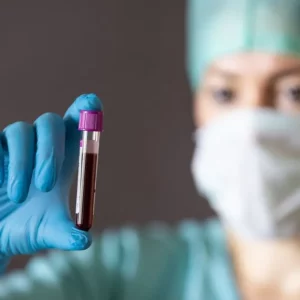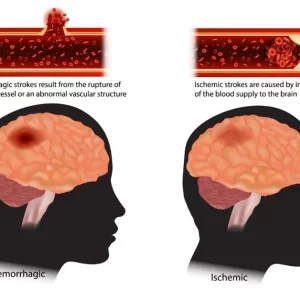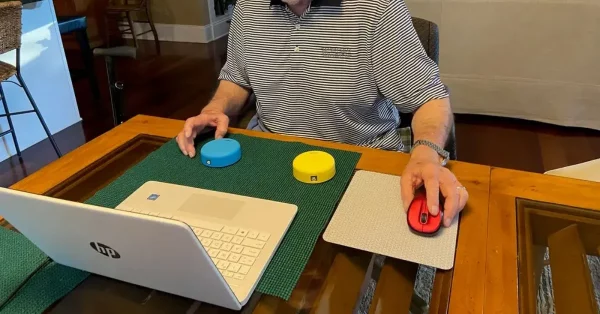A massive stroke is a significant medical event that damages brain cells. It can be fatal or lead to significant secondary effects such as a coma or paralysis. While the initial prognosis may be grim, there is hope for massive stroke recovery.
This post will explain the potential secondary effects of a massive stroke and steps toward rehabilitation. The journey may be long, but with the right approach, massive stroke recovery occurs.
Use the links below to jump straight to any section:
- What Is a Massive Stroke?
- Massive Stroke Recovery Prognosis
- How the Brain Recovers After a Stroke
- Potential Secondary Effects of Massive Stroke
- Methods for Massive Stroke Recovery
- Understanding Massive Stroke
What Is a Massive Stroke?
A stroke results from a loss of blood supply in the brain. When blood flow in the brain is interrupted by a clot, it’s called an ischemic stroke. When an artery in the brain bursts, causing uncontrollable bleeding, it’s called a hemorrhagic stroke.
In either case, brain tissue damage occurs when brain cells do not receive oxygen and nutrients from the blood. After a massive stroke, larger areas of the brain are substantially affected or die. While you cannot revive dead brain cells, healthy areas of the brain can take over some new functions.
Before we dig into that process, it helps to understand the typical prognosis for a massive stroke.
Massive Stroke Recovery Prognosis
Medical experts often use the NIH Stroke Scale to determine the severity of a stroke. Patients who score between 21 and 42 (the highest possible score) are considered to have suffered a massive stroke.
When asking your medical team what to expect after a massive stroke, they may use your score to provide a rough prognosis. However, every stroke is different and every recovery will be different. This makes it almost impossible for doctors to provide an accurate prognosis for all patients who suffer a massive stroke.
Therefore, it’s important to follow through with rehabilitation to see what type of recovery is achievable for you. While one specialist may claim that recovery plateaus after 1-2 years, you might prove that you can see gains up to 5 years later.
To get the most from your massive stroke recovery, it helps to understand how the brain heals from damage.
How the Brain Recovers After a Stroke
Massive stroke recovery depends on healing the brain to restore function in the body. Fortunately, the brain has an innate ability to heal itself after injury, even large injuries like a massive stroke.
Through the phenomenon of neuroplasticity, healthy areas of the brain take over the functions of damaged areas. While the recovery process takes time and hard work, there is hope for massive stroke recovery.
Neuroplasticity depends on experience. Whatever you are repeatedly exposed to, or whatever you repeatedly practice, your brain becomes more efficient executing.
This is why stroke survivors often start rehabilitation before they are even discharged from the hospital. The medical team needs to expose the brain to therapeutic experiences to get the recovery process started as soon as possible.
After discharge from the hospital and inpatient therapy, stroke survivors can maximize recovery from a massive stroke by continuing rehabilitation at home. It often takes years to recover from the effects of a massive stroke, but long-term rehabilitation is the best-known way to recover.
After listing the common side effects of a massive stroke, we list over a dozen rehabilitation methods you can use to keep recovery going.
Potential Secondary Effects of Massive Stroke
The location of the stroke has a substantial impact on the side effects experienced. For example, a left-hemisphere stroke is more likely to lead to language difficulties than a right-hemisphere stroke; because the language center of the brain resides in the left hemisphere.
Talk to your neurologist to understand where your stroke occurred. This will help you better understand what to expect after a massive stroke.
Here are the most common side effects of a massive stroke:
- Post-stroke paralysis. Loss of motor function is one of the most common stroke side effects. For a mild stroke survivor, the motor loss might manifest as weakness on the affected side (hemiparesis). For a massive stroke survivor, motor loss could mean paralysis on the affected side (hemiplegia).
- Coma after stroke. Falling into a coma after a stroke is more common after a massive stroke or brain stem stroke. It’s possible that someone in a coma can still hear you, so talk to your loved one and speak words of encouragement.
- Severe speech difficulties. Difficulty with speech after a stroke is a condition called aphasia. In some cases, massive stroke survivors cannot talk at all. But do not loose hope for some recovery and the implementation of new compensatory techniques to communicate.
- Difficulty swallowing. A condition called dysphagia can make it difficult for stroke survivors to swallow. They may require a feeding tube while in the hospital until swallowing abilities are regained.
- Difficulty breathing. Some massive stroke patients cannot breathe on their own and require a ventilator. These patients require intensive care in a long-term acute hospital.
- Cognitive difficulties. Sometimes a stroke can impair a person’s critical thinking or memory skills. Generally speaking, a severe stroke may lead to more severe cognitive difficulties.
- One-sided neglect. A condition called hemineglect can make it hard for a stroke patient to notice things in the environment on their affected side. They may eat only half of their plate because they do not recognize that there’s food on the other half.
- Sensory loss. If the areas of the brain that contribute to sensory loss are compromised, it can lead to sensory disorders after stroke. A common example is numbness after a stroke. It can also include tingling sensations, difficulty feeling hot/cold, and more.
- Vision problems. Vision is also processed by the brain. If the visual cortex has been damaged, it can cause vision problems like partial blindness.
- Spasticity and contractures. Spasticity is characterized by muscle stiffness that occurs when a stroke interferes with the signals sent between the brain and body. When spasticity is severe, it can result in contractures where the joints become extremely stiff (as seen with clenched hands after a stroke).
Methods for Massive Stroke Recovery
Stroke rehabilitation focuses on harnessing the brain’s natural ability to heal itself after injury by exposing the brain to therapeutic experiences. The best results occur when rehabilitation is pursued consistently and long-term.
With that said, here are the best rehabilitation methods for massive stroke survivors:
1. Range of motion exercises
After a massive stroke, it’s important to keep the limbs moving and stretch them with ROM exercises. This is necessary to prevent muscles from shortening and making movement more challenging once nerves have regrown. It can also prevent spasticity from worsening and help prevent bedsores.
2. Physical therapy exercises
Massive stroke recovery will often include Physical Therapy, Occupational Therapy, and Speech Therapy. Each profession will set specific goals for you to achieve.
Each therapy will help retrain the brain to control your muscles. After discharge from inpatient therapy, it’s important to continue with OT, PT, and Speech while home. It takes time for your nerve cells to grow and respond to your hard work. Massive stroke recovery does not end once you are home, in fact, it is likely just beginning.
See all physical therapy stroke exercises »
3. Passive exercise
If you have paralysis after a massive stroke, then you will require assistance to complete passive exercises. This is important during massive stroke recovery.
Some passive exercises involve moving your body parts with your non-affected arm. Although one limb is dependent on the other to move, this movement still helps spark neuroplasticity.
Learn more about passive exercise »
4. Electrical stimulation
Massive stroke survivors who struggle with paralysis can greatly benefit from electrical stimulation. When electrical currents are applied to the affected muscles, it supplies the brain with significant stimulation. This helps spark the rewiring process. When electrical stimulation is paired with physical therapy exercises, it’s even more effective.
Learn more about electrical stimulation »
5. Constraint-Induced Movement Therapy
Many research studies have shown the effectiveness of Constraint-induced movement therapy after a stroke. It involves restricting the non-affected arm to force use of the affected arm. This type of rehabilitation therapy is difficult, which can be frustrating for the patient, but it’s clinically proven to be effective.
6. Mirror therapy
Mirror therapy helps patients recover hand use by tricking the brain into thinking you’re moving your affected hand. Ask your OT or PT about this, as it’s growing in popularity due to its effectiveness.
Learn more about mirror therapy »
7. Mental practice
Another great way to spark neuroplasticity is by visualizing your affected limbs moving. In the stroke rehabilitation field, this is referred to as mental practice or motor imagery. With repetition and in combination with your therapy, it has been demonstrated to improve motor deficits after stroke. During massive stroke recovery, multiple approaches to rehabilitation help boost results.
Learn more about mental practice »
8. Botox (for motor improvement)
Massive stroke survivors who struggle with severe spasticity may benefit from Botox injections. This drug helps temporarily reduce spasticity. Although the results are temporary, patients can use the improved mobility to practice rehab exercises. This can be very effective in addressing spasticity and can lead to long-term results.
9. Electroacupuncture
Electroacupuncture is a treatment that combines electrical stimulation with acupuncture. When combined with physical therapy, it has been found to help improve spasticity in patients during massive stroke recovery.
Alternative treatments are making their way into the stroke rehabilitation field. Ask your therapist about some form of electrical stimulation for massive stroke recovery.
Learn more about acupuncture for stroke recovery »
10. Speech therapy

If you have some ability to speak, but you need help improving your speech and/or cognitive abilities, then speech therapy can help. Working with these experts (Speech-Language Pathologists) can also help you regain the ability to swallow, too.
Speech therapy is common during massive stroke recovery. Many patients will receive help from an SLP for several months after stroke and then need to continue with therapy at home to optimize massive stroke recovery. Apps like the CT Speech & Cognitive Therapy App can help you continue your work at home.
Learn more about speech therapy »
11. Singing therapy
If a stroke patient cannot talk at all, they might be able to sing their words. That’s because singing is controlled by the right hemisphere while talking is a left hemispheric function. Singing therapy takes hard work, but it provides hope for getting your voice back.
Learn more about singing therapy »
12. Sensory reeducation
If you struggle with changes in sensation after a massive stroke, like numbness or tingling, then sensory reeducation exercises can help. They retrain the brain on how to process sensory input, which may help improve sensory issues like numbness.
Learn more about sensory reeducation »
13. Vision training
Vision training can help improve vision problems in some stroke survivors. These programs utilize various eye exercises to help retrain the brain how to process visual input.
Learn more improving your sight after a stroke »
Understanding Massive Stroke
A massive stroke is a significant medical event that can alter major abilities, such as movement and communication. Although the side effects can be severe, the brain is capable of recovering from the damage through therapy.
Patients who survive a massive stroke should participate in rigorous rehabilitation programs to recover as much movement as possible beyond their time in the hospital or even outpatient clinics. Physical Therapy, Occupational Therapy, and Speech Therapy are usually necessary and those exercises learned should be continued for a long time after the initial event.
The road to recovery will look different for each massive stroke survivor. Patients can have hope because of neuroplasticity: the brain’s innate ability to rewire itself and relearn some function after injury.









